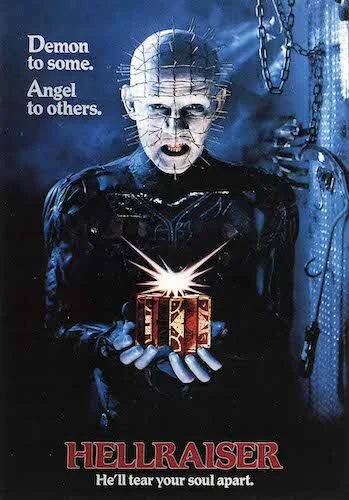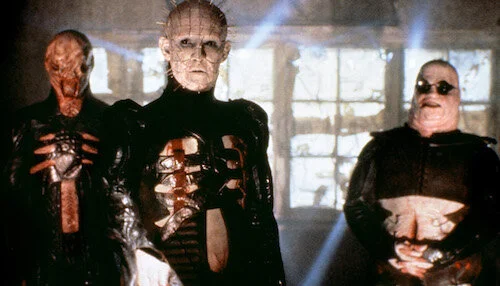Hellraiser: 31 Days of Horror
For all of October, we will review horror films. Submit your requests here, and you may see your picks selected!
Hellraiser kind of feels like Saw before Saw — and the series that followed — were made. It’s a gore fest disguised as some sort of morality tale, but really no one that is watching is wanting to be enlightened about the tests of life: they just want to see guts. And guts they shall receive, especially with Hellraiser’s exceptionally strange forms of violence (particularly the destruction of the human body in sadomasochistic ways. The main monsters here are Cenobites, and they can no longer differentiate between tenderness and pain. They deem themselves both angels and devils. Like Hannibal Lecter in The Silence of the Lambs, they’re not really the main villain, despite their reputation in pop culture. They’re more or less the instigators of the story. They can help, and they can deter. They can go as far as kill, too. Cenobites are a gamble to deal with. They’re fascinating that way.
The main story we get (which is revealed as a bit of a story within the Cenobite lore, which is a nice, subtle way to lead into more films if this was a success) is of the Cotton family, of whom are cursed by the puzzle box that summons the Cenobites from their own dimension of indescribable misery. From there comes the test of this family, already tainted by the brutal murder of Frank (whose story doesn’t quite end at the start of this feature, either). The Cotton family is meant to be a tabula rasa of any unlucky participants of this whole ordeal, I suppose, but all I can see between the basic name and their position in the film is another white common commodity: vanilla. There isn’t much nuance to these characters outside of what their performers can extract from the screenwriting. I honestly feel like you could replace these characters with any other groups of people, outside of the occasional heroics that take place.
Off topic: here’s a photo from a family gathering from the other day.
That’s when it becomes abundantly clear that Hellraiser was never invested in deepening this horror lore it has created, or really creating a story of substance. As the slasher films of the ‘80s were now in full effect, it just feels like Clive Barker and company wanted to capitalize on this trend. What I can commend is how creative the horrors in this film are, especially with the psychosexual, unorthodox torture that takes place. Then again, if you replace skin ripping and hooks with a machete or a chainsaw, and Cenobites with some serial killers or disturbed individuals, you’d have another slasher more or less. There’s really not a hell of a lot that’s different here, outside of the ability to connect to the other realm, and the unpredictability of the Cenobites. If Hellraiser didn’t have those two elements, it would be cookie cutter material entirely. As a slasher, Hellraiser is a bit of a different taste. As a film overall, outside of how uncomfortable you will feel staring at images you can’t comprehend right away, it’s so-so. A film that’s this violent can also be bland? That sounds like a Cenobite type of problem, because Hellraiser can’t understand entertainment past gore.
Andreas Babiolakis has a Masters degree in Film and Photography Preservation and Collections Management from Ryerson University, as well as a Bachelors degree in Cinema Studies from York University. His favourite times of year are the Criterion Collection flash sales and the annual Toronto International Film Festival.






